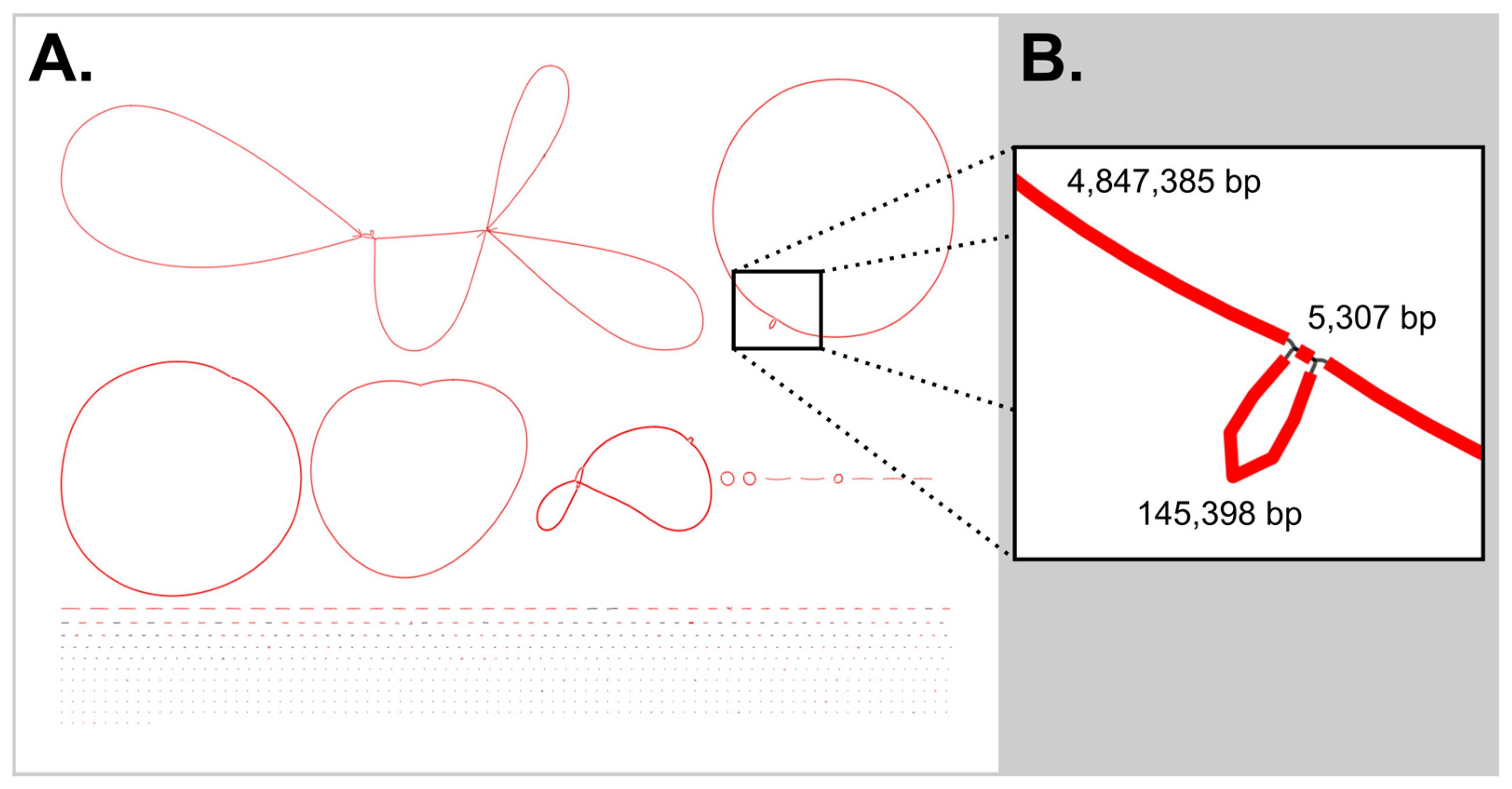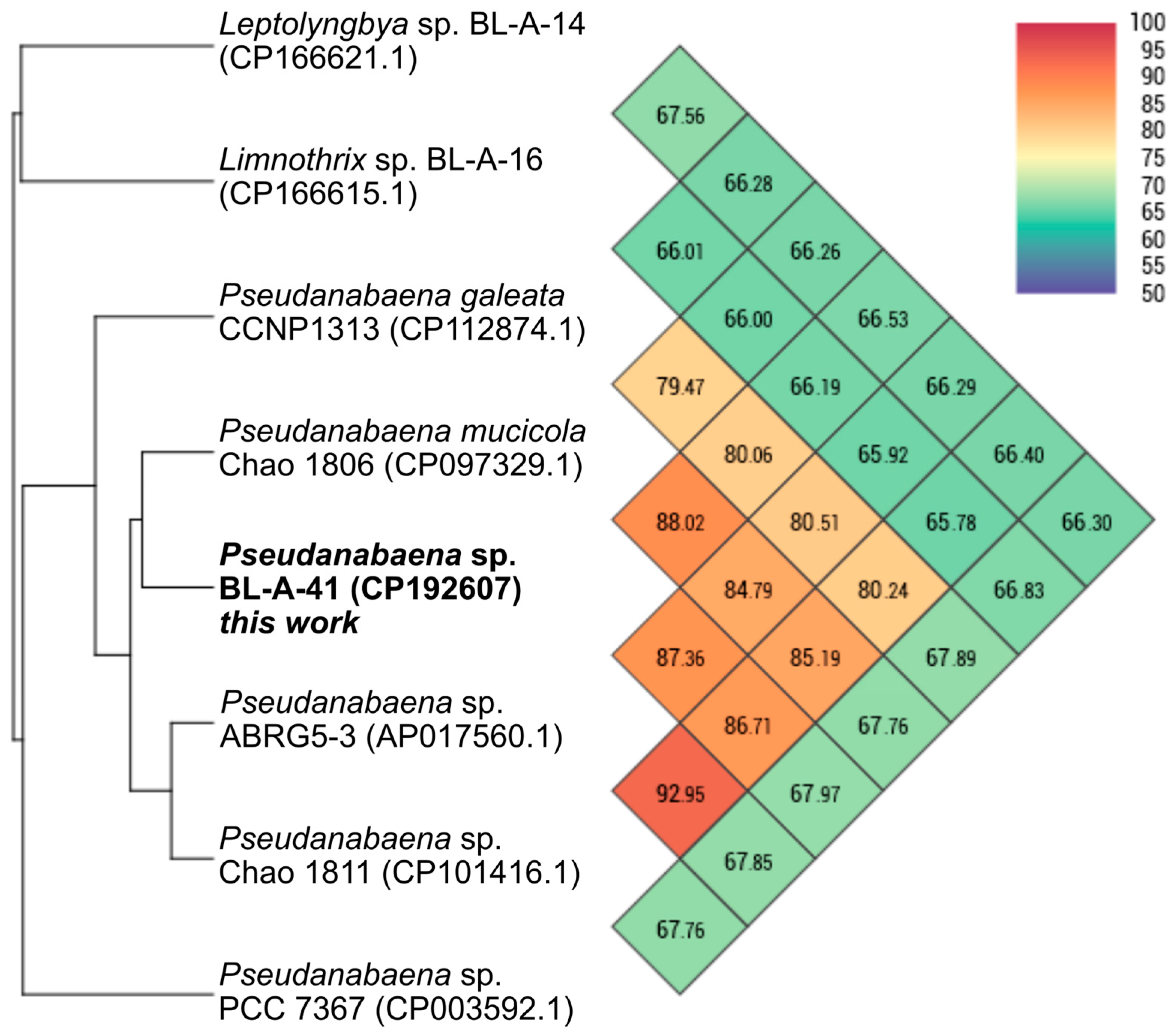Metagenomic Assembled Genomes of a Pseudanabaena Cyanobacterium and Six Heterotrophic Strains from a Xenic Culture
Abstract
1. Introduction
2. Materials and Methods
2.1. Strain and Harvesting
2.1.1. Strain Isolation and Growth
2.1.2. Cell Harvesting
2.2. DNA Extraction, Size Selection, and Sequencing
2.2.1. Single DNA Extraction
2.2.2. Iterative DNA Extraction
2.2.3. Bead-Based Size Selection
2.2.4. Nanopore Whole Genome Sequencing
2.2.5. Nanopore Targeted Amplicon Sequencing
2.3. Bioinformatic Analyses
2.3.1. Metagenomic Assembly
2.3.2. Preliminary 16S-Based Identification
2.3.3. Mapping of Reads to Genomes
2.3.4. Genome Comparison with the OrthoANI Tool (OAT) [28]
2.3.5. Preliminary Analysis of Natural Product Biosynthetic Capacity with antiSMASH [20]
3. Results
3.1. Iterative Fractionation Allowed for Better Recovery of Cyanobacterial DNA Versus a Single Extraction
3.2. Bead-Based Size Selection Provided Sufficient Removal of Sheared DNA Fragments to Allow for Sequencing with a Commercial Vendor
3.3. Bioinformatic Analysis Supported the Assignment of BL-A-41 as Belonging to the Genus Pseudanabaena
4. Discussion
Supplementary Materials
Funding
Institutional Review Board Statement
Informed Consent Statement
Data Availability Statement
Acknowledgments
Conflicts of Interest
Abbreviations
| antiSMASH | Antibiotics and Secondary Metabolite Analysis Shell |
| COBRE-NPN | Center of Biomedical Research Excellence in Natural Products Neuroscience |
| DFAST | DNA Data Bank of Japan Fast Annotation and Submission Tool |
| DNA | Deoxyribonucleic Acid |
| dsDNA | Double-Stranded Deoxyribonucleic Acid |
| EEO | Electroendosmosis |
| GGDC | Genome-to-Genome Distance Calculator |
| LCMS | Liquid Chromatography–Mass Spectrometry |
| LED | Light-Emitting Diode |
| MAG | Metagenome Assembled Genome |
| OAT | Orthro Average Nucleotide Identity Tool |
| NRPS | Nonribosomal Peptide Synthetases |
| PCR | Polymerase Chain Reaction |
| PKS | Polyketide Synthases |
| RRE | RiPPs (Ribosomally Synthesized and Post-Translationally Modified Peptide Product) Recognition Element |
| UTEX | Culture Collection of Algae, The University of Texas at Austin |
References
- Castenholz, R.W. General Characteristics of the Cyanobacteria. In Bergey’s Manual of Systematics of Archaea and Bacteria; DeVos, P., Ed.; John Wiley & Sons: Hoboken, NJ, USA, 2015. [Google Scholar] [CrossRef]
- Sánchez-Baracaldo, P.; Bianchini, G.; Wilson, J.D.; Knoll, A.H. Cyanobacteria and Biogeochemical Cycles through Earth History. Trends Microbiol. 2022, 30, 143–157. [Google Scholar] [CrossRef]
- Schirrmeister, B.E.; Gugger, M.; Donoghue, P.C.J. Cyanobacteria and the Great Oxidation Event: Evidence from Genes and Fossils. Palaeontology 2015, 58, 769–785. [Google Scholar] [CrossRef]
- Herrero, A.; Muro-Pastor, A.M.; Flores, E. Nitrogen Control in Cyanobacteria. J. Bacteriol. 2001, 183, 411–425. [Google Scholar] [CrossRef]
- Baunach, M.; Guljamow, A.; Miguel-Gordo, M.; Dittmann, E. Harnessing the Potential: Advances in Cyanobacterial Natural Product Research and Biotechnology. Nat. Prod. Rep. 2023, 41, 347–369. [Google Scholar] [CrossRef]
- Morin, N.; Vallaeys, T.; Hendrickx, L.; Natalie, L.; Wilmotte, A. An Efficient DNA Isolation Protocol for Filamentous Cyanobacteria of the Genus Arthrospira. J. Microbiol. Methods 2010, 80, 148–154. [Google Scholar] [CrossRef] [PubMed]
- Ohbayashi, R.; Nakamachi, A.; Hatakeyama, T.S.; Watanabe, S.; Kanesaki, Y.; Chibazakura, T.; Yoshikawa, H.; Miyagishima, S.Y. Coordination of Polyploid Chromosome Replication with Cell Size and Growth in a Cyanobacterium. MBio 2019, 10, e00510-19. [Google Scholar] [CrossRef] [PubMed]
- Moss, N.A.; Leao, T.; Glukhov, E.; Gerwick, L.; Gerwick, W.H. Collection, Culturing, and Genome Analyses of Tropical Marine Filamentous Benthic Cyanobacteria. Methods Enzymol. 2018, 604, 3–43. [Google Scholar] [CrossRef]
- Cummings, S.L.; Barbé, D.; Leao, T.F.; Korobeynikov, A.; Engene, N.; Glukhov, E.; Gerwick, W.H.; Gerwick, L. A Novel Uncultured Heterotrophic Bacterial Associate of the Cyanobacterium Moorea producens JHB. BMC Microbiol. 2016, 16, 198. [Google Scholar] [CrossRef]
- Pérez-Carrascal, O.M.; Tromas, N.; Terrat, Y.; Moreno, E.; Giani, A.; Corrêa Braga Marques, L.; Fortin, N.; Shapiro, B.J. Single-Colony Sequencing Reveals Microbe-by-Microbiome Phylosymbiosis between the Cyanobacterium Microcystis and Its Associated Bacteria. Microbiome 2021, 9, 194. [Google Scholar] [CrossRef] [PubMed]
- Leao, T.; Castelão, G.; Korobeynikov, A.; Monroe, E.A.; Podell, S.; Glukhov, E. Comparative Genomics Uncovers the Prolific and Distinctive Metabolic Potential of the Cyanobacterial Genus Moorea. Proc. Natl. Acad. Sci. USA 2017, 114, 3198–3203. [Google Scholar] [CrossRef]
- Saeed, H.K.; Alsammak, E.G.; Haddad, M.F. Draft Genome Sequencing of Microcoleus sp. HI-ES Isolated from Freshwater in Iraq: Cyanobacterial Strain. Biomed. Biotechnol. Res. J. 2024, 8, 129–134. [Google Scholar] [CrossRef]
- Australian Centre for Ecogenomics. Genome Taxonomy Database. Release 10-RS226. Available online: https://gtdb.ecogenomic.org/ (accessed on 12 August 2025).
- Baltz, R.H. Renaissance in Antibacterial Discovery from Actinomycetes. Curr. Opin. Pharmacol. 2008, 8, 557–563. [Google Scholar] [CrossRef]
- Baltz, R.H. Gifted Microbes for Genome Mining and Natural Product Discovery. J. Ind. Microbiol. Biotechnol. 2017, 44, 573–588. [Google Scholar] [CrossRef] [PubMed]
- Wagner, A.D.; Ahmed, M.M.A.; Starks, V.; Boudreau, P.D. Using Repeated Lysis Steps Fractionates Between Heterotrophic and Cyanobacterial DNA Extracted from Xenic Cyanobacterial Cultures. Genes Genomes Genet. 2025, 15, jkaf135. [Google Scholar] [CrossRef]
- Hirose, Y.; Ohtsubo, Y.; Misawa, N.; Yonekawa, C.; Nagao, N.; Shimura, Y.; Fujisawa, T.; Kanesaki, Y.; Katoh, H.; Katayama, M.; et al. Genome Sequencing of the NIES Cyanobacteria Collection with a Focus on the Heterocyst-Forming Clade. DNA Res. 2021, 28, dsab024. [Google Scholar] [CrossRef] [PubMed]
- D’Agostino, P.M. Highlights of Biosynthetic Enzymes and Natural Products from Symbiotic Cyanobacteria. Nat. Prod. Rep. 2023, 40, 1701–1717. [Google Scholar] [CrossRef]
- Khalifa, S.A.M.; Shedid, E.S.; Saied, E.M.; Jassbi, A.R.; Jamebozorgi, F.H.; Rateb, M.E.; Du, M.; Abdel-Daim, M.M.; Kai, G.Y.; Al-Hammady, M.A.M.; et al. Cyanobacteria—From the Oceans to the Potential Biotechnological and Biomedical Applications. Mar. Drugs 2021, 19, 241. [Google Scholar] [CrossRef]
- Blin, K.; Shaw, S.; Augustijn, H.E.; Reitz, Z.L.; Biermann, F.; Alanjary, M.; Fetter, A.; Terlouw, B.R.; Metcalf, W.W.; Helfrich, E.J.N.; et al. Antismash 7.0: New and Improved Predictions for Detection, Regulation, Chemical Structures and Visualisation. Nucleic Acids Res. 2023, 51, W46–W50. [Google Scholar] [CrossRef] [PubMed]
- Wagner, A.D. Genomic and Metabolomic Investigation into Xenic Cyanobacterial and Algal Cultures from Northern Mississippi. Master’s Thesis, University of Mississippi, Oxford, MS, USA, 2023. [Google Scholar]
- University of Texas at Austin Culture Collection of Algae. BG-11 Medium. Available online: https://utex.org/products/bg-11-medium?variant=30991786868826 (accessed on 27 February 2025).
- Boyer, S.L.; Flechtner, V.R.; Johansen, J.R. Is the 16S-23S rRNA Internal Transcribed Spacer Region a Good Tool for Use in Molecular Systematics and Population Genetics? A Case Study in Cyanobacteria. Mol. Biol. Evol. 2001, 18, 1057–1069. [Google Scholar] [CrossRef]
- Sherwood, A.R.; Presting, G.G. Universal Primers Amplify a 23S rDNA Plastid Marker in Eukaryotic Algae and Cyanobacteria. J. Phycol. 2007, 43, 605–608. [Google Scholar] [CrossRef]
- Kolmogorov, M.; Yuan, J.; Lin, Y.; Pevzner, P.A. Assembly of Long, Error-Prone Reads Using Repeat Graphs. Nat. Biotechnol. 2019, 37, 540–546. [Google Scholar] [CrossRef]
- Tanizawa, Y.; Fujisawa, T.; Nakamura, Y. DFAST: A Flexible Prokaryotic Genome Annotation Pipeline for Faster Genome Publication. Bioinformatics 2018, 34, 1037–1039. [Google Scholar] [CrossRef]
- Camargo, A.P.; Roux, S.; Schulz, F.; Babinski, M.; Xu, Y.; Hu, B.; Chain, P.S.G.; Nayfach, S.; Kyrpides, N.C. Identification of Mobile Genetic Elements with Genomad. Nat. Biotechnol. 2024, 42, 1303–1312. [Google Scholar] [CrossRef]
- Lee, I.; Kim, Y.O.; Park, S.C.; Chun, J. OrthoANI: An Improved Algorithm and Software for Calculating Average Nucleotide Identity. Int. J. Syst. Evol. Microbiol. 2016, 66, 1100–1103. [Google Scholar] [CrossRef] [PubMed]
- Seid, J.; Boudreau, P.D. Complete Genome Sequence of Novosphingobium sp. Strain BL-52-GroH Shows Unusual Dual Chromosome Architecture. Microbiol. Resour. Announc. 2025, 14, e01304-24. [Google Scholar] [CrossRef] [PubMed]
- D’Onofrio, A.; Crawford, J.M.; Stewart, E.J.; Witt, K.; Gavrish, E.; Epstein, S.; Clardy, J.; Lewis, K. Siderophores from Neighboring Organisms Promote the Growth of Uncultured Bacteria. Chem. Biol. 2010, 17, 254–264. [Google Scholar] [CrossRef] [PubMed]
- Kramer, J.; Özkaya, Ö.; Kümmerli, R. Bacterial Siderophores in Community and Host Interactions. Nat. Rev. Microbiol. 2020, 18, 152–163. [Google Scholar] [CrossRef]
- Bauvais, C.; Zirah, S.; Piette, L.; Chaspoul, F.; Domart-Coulon, I.; Chapon, V.; Gallice, P.; Rebuffat, S.; Pérez, T.; Bourguet-Kondracki, M.L. Sponging up Metals: Bacteria Associated with the Marine Sponge Spongia officinalis. Mar. Environ. Res. 2015, 104, 20–30. [Google Scholar] [CrossRef]
- Ellis, G.A.; Thomas, C.S.; Chanana, S.; Adnani, N.; Szachowicz, E.; Braun, D.R.; Harper, M.K.; Wyche, T.P.; Bugni, T.S. Brackish Habitat Dictates Cultivable Actinobacterial Diversity from Marine Sponges. PLoS ONE 2017, 12, e0176968. [Google Scholar] [CrossRef]
- Bhushan, A.; Egli, P.J.; Peters, E.E.; Freeman, M.F.; Piel, J. Genome Mining- and Synthetic Biology-Enabled Production of Hypermodified Peptides. Nat. Chem. 2019, 11, 931–939. [Google Scholar] [CrossRef]
- Molnár, K.; Farkas, E. Current Results on Biological Activities of Lichen Secondary Metabolites: A Review. Z. Naturforsch. C 2010, 65, 157–173. [Google Scholar] [CrossRef]
- Lutzoni, F.; Miadlikowska, J. Lichens. Curr. Biol. 2009, 19, 502–503. [Google Scholar] [CrossRef] [PubMed]
- Hinlo, R.; Gleeson, D.; Lintermans, M.; Furlan, E. Methods to Maximise Recovery of Environmental DNA from Water Samples. PLoS ONE 2017, 12, e0179251. [Google Scholar] [CrossRef] [PubMed]
- Kumar, G.; Eble, J.E.; Gaither, M.R. A Practical Guide to Sample Preservation and Pre-PCR Processing of Aquatic Environmental DNA. Mol. Ecol. Resour. 2020, 20, 29–39. [Google Scholar] [CrossRef] [PubMed]
- Wydro, U. Soil Microbiome Study Based on DNA Extraction: A Review. Water 2022, 14, 3999. [Google Scholar] [CrossRef]
- Kaneko, T.; Nakajima, N.; Okamoto, S.; Suzuki, I.; Tanabe, Y.; Tamaoki, M.; Nakamura, Y.; Kasai, F.; Watanabe, A.; Kawashima, K.; et al. Complete Genomic Structure of the Bloom-Forming Toxic Cyanobacterium Microcystis aeruginosa NIES-843. DNA Res. 2007, 14, 247–256. [Google Scholar] [CrossRef]
- Castenholz, R.W.; Waterbury, J.B. Group I. Cyanobacteria. In Bergey’s Manual of Systematic Bacteriology Volume 3; Staley, J.T., Bryant, M.P., Pfenning, N., Holt, J.G., Eds.; Williams & Wilkins: Baltimore, MD, USA, 1989; pp. 1710–1806. [Google Scholar]
- Lopez-Igual, R.; Mazel, D.; Gugger, M.; Golden, S.S.; Adomako, M.; Ernst, D.; Simkovsky, R.; Chao, Y.Y.; Wang, J.; Fang, M.; et al. Comparative Genomics of Synechococcus elongatus Explains the Phenotypic Diversity of the Strains. MBio 2022, 13, e00862-22. [Google Scholar] [CrossRef]
- Kono, M.; Martinez, J.N.; Sato, T.; Haruta, S. Draft Genome Sequence of the Thermophilic Unicellular Cyanobacterium Synechococcus sp. Strain C9. Microbiol. Resour. Announc. 2022, 11, e00294-22. [Google Scholar] [CrossRef]


| Genome Target for Mapping | Single DNA Extraction Reads | Iterative DNA Extraction Reads | ||
|---|---|---|---|---|
| Fraction A | Fraction B | Fraction C | ||
| Total Reads | 130,032 | 297,976 | 426,824 | 384,944 |
| Pseudanabaena sp. BL-A-41 | 2142 (1.6%) | 36,339 (12%) | 95,890 (22%) | 54,116 (14%) |
| Acidovorax sp. BL-A-41-H1 | 8769 (6.7%) | 22,754 (7.6%) | 27,850 (6.5%) | 22,252 (5.6%) |
| Hydrogenophaga sp. BL-A-41-H2 | 4422 (3.4%) | 24,185 (8.1%) | 26,874 (6.3%) | 20,161 (5.2%) |
| Lysobacter sp. BL-A-41-H3 | 53,670 (41%) | 77,723 (26%) | 98,430 (23%) | 117,471 (31%) |
| Novosphingobium sp. BL-A-41-H4 | 57,540 (44%) | 94,858 (32%) | 117,844 (28%) | 109,502 (28%) |
| Sediminicoccus sp. BL-A-41-H5 | 1818 (1.4%) | 8406 (2.8%) | 15,457 (3.6%) | 24,481 (6.4%) |
| Tabrizicola sp. BL-A-41-H6 | 2167 (1.7%) | 33,090 (11%) | 42,264 (9.9%) | 34,723 (9.0%) |
Disclaimer/Publisher’s Note: The statements, opinions and data contained in all publications are solely those of the individual author(s) and contributor(s) and not of MDPI and/or the editor(s). MDPI and/or the editor(s) disclaim responsibility for any injury to people or property resulting from any ideas, methods, instructions or products referred to in the content. |
© 2025 by the author. Licensee MDPI, Basel, Switzerland. This article is an open access article distributed under the terms and conditions of the Creative Commons Attribution (CC BY) license (https://creativecommons.org/licenses/by/4.0/).
Share and Cite
Boudreau, P.D. Metagenomic Assembled Genomes of a Pseudanabaena Cyanobacterium and Six Heterotrophic Strains from a Xenic Culture. Microorganisms 2025, 13, 1996. https://doi.org/10.3390/microorganisms13091996
Boudreau PD. Metagenomic Assembled Genomes of a Pseudanabaena Cyanobacterium and Six Heterotrophic Strains from a Xenic Culture. Microorganisms. 2025; 13(9):1996. https://doi.org/10.3390/microorganisms13091996
Chicago/Turabian StyleBoudreau, Paul D. 2025. "Metagenomic Assembled Genomes of a Pseudanabaena Cyanobacterium and Six Heterotrophic Strains from a Xenic Culture" Microorganisms 13, no. 9: 1996. https://doi.org/10.3390/microorganisms13091996
APA StyleBoudreau, P. D. (2025). Metagenomic Assembled Genomes of a Pseudanabaena Cyanobacterium and Six Heterotrophic Strains from a Xenic Culture. Microorganisms, 13(9), 1996. https://doi.org/10.3390/microorganisms13091996







